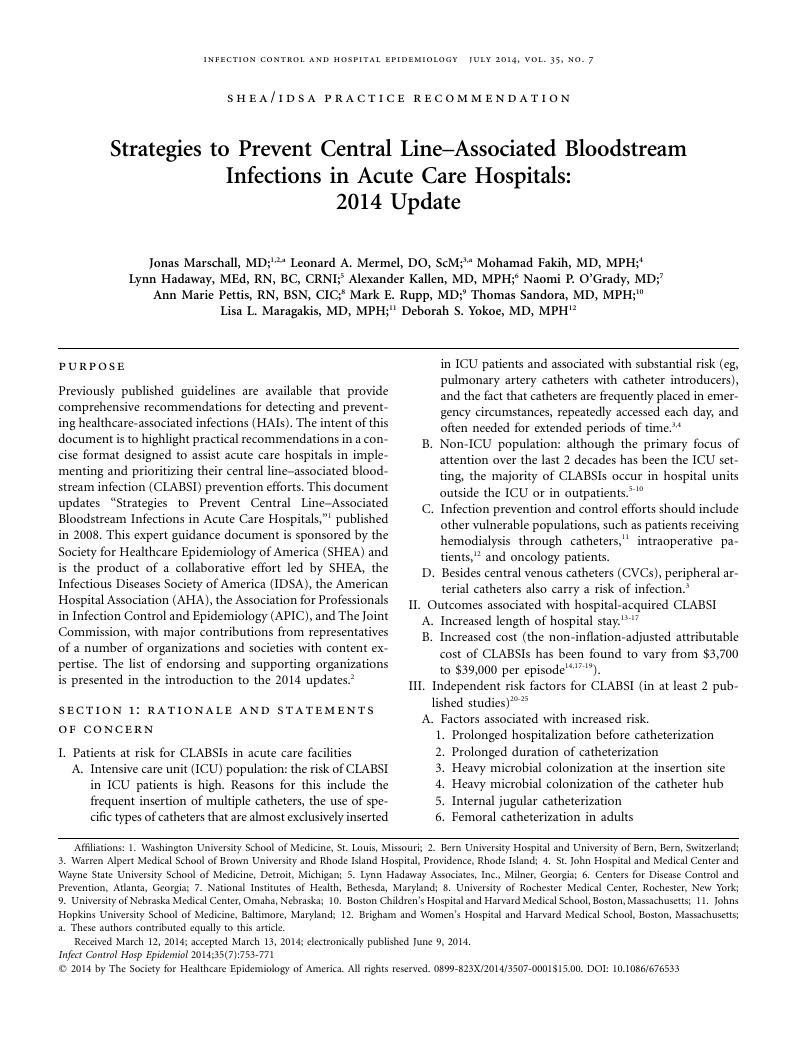Crossref Citations
This article has been cited by the following publications. This list is generated based on data provided by Crossref.
Calfee, David P.
Salgado, Cassandra D.
Milstone, Aaron M.
Harris, Anthony D.
Kuhar, David T.
Moody, Julia
Aureden, Kathy
Huang, Susan S.
Maragakis, Lisa L.
and
Yokoe, Deborah S.
2014.
Strategies to Prevent Methicillin-ResistantStaphylococcus aureusTransmission and Infection in Acute Care Hospitals: 2014 Update.
Infection Control & Hospital Epidemiology,
Vol. 35,
Issue. 7,
p.
772.
Barnett, Adrian G.
Page, Katie
Campbell, Megan
Brain, David
Martin, Elizabeth
Winters, Shirley
Hall, Lisa
Paterson, David
and
Graves, Nicholas
2014.
Changes in healthcare-associated infections after the introduction of a national hand hygiene initiative.
Healthcare infection,
Vol. 19,
Issue. 4,
p.
128.
Yokoe, Deborah S.
Anderson, Deverick J.
Berenholtz, Sean M.
Calfee, David P.
Dubberke, Erik R.
Eilingson, Katherine D.
Gerding, Dale N.
Haas, Janet P.
Kaye, Keith S.
Klompas, Michael
Lo, Evelyn
Marschall, Jonas
Mermel, Leonard A.
Nicolle, Lindsay E.
Salgado, Cassandra D.
Bryant, Kristina
Classen, David
Crist, Katrina
Deloney, Valerie M.
Fishman, Neil O.
Foster, Nancy
Goldmann, Donald A.
Humphreys, Eve
Jernigan, John A.
Padberg, Jennifer
Perl, Trish M.
Podgorny, Kelly
Septimus, Edward J.
VanAmringe, Margaret
Weaver, Tom
Weinstein, Robert A.
Wise, Robert
and
Maragakis, Lisa L.
2014.
A Compendium of Strategies to Prevent Healthcare-Associated Infections in Acute Care Hospitals: 2014 Updates.
Infection Control & Hospital Epidemiology,
Vol. 35,
Issue. S2,
p.
S21.
Septimus, Edward
Weinstein, Robert A.
Perl, Trish M.
Goldmann, Donald A.
and
Yokoe, Deborah S.
2014.
Approaches for Preventing Healthcare-Associated Infections: Go Long or Go Wide?.
Infection Control & Hospital Epidemiology,
Vol. 35,
Issue. S2,
p.
S10.
Yokoe, Deborah S.
Anderson, Deverick J.
Berenholtz, Sean M.
Calfee, David P.
Dubberke, Erik R.
Ellingson, Katherine D.
Gerding, Dale N.
Haas, Janet P.
Kaye, Keith S.
Klompas, Michael
Lo, Evelyn
Marschall, Jonas
Mermel, Leonard A.
Nicolle, Lindsay E.
Salgado, Cassandra D.
Bryant, Kristina
Classen, David
Crist, Katrina
Deloney, Valerie M.
Fishman, Neil O.
Foster, Nancy
Goldmann, Donald A.
Humphreys, Eve
Jernigan, John A.
Padberg, Jennifer
Perl, Trish M.
Podgorny, Kelly
Septimus, Edward J.
VanAmringe, Margaret
Weaver, Tom
Weinstein, Robert A.
Wise, Robert
and
Maragakis, Lisa L.
2014.
A Compendium of Strategies to Prevent Healthcare-Associated Infections in Acute Care Hospitals: 2014 Updates.
Infection Control & Hospital Epidemiology,
Vol. 35,
Issue. 8,
p.
967.
Calfee, David P.
Salgado, Cassandra D.
Milstone, Aaron M.
Harris, Anthony D.
Kuhar, David T.
Moody, Julia
Aureden, Kathy
Huang, Susan S.
Maragakis, Lisa L.
and
Yokoe, Deborah S.
2014.
Strategies to Prevent Methicillin-ResistantStaphylococcus aureusTransmission and Infection in Acute Care Hospitals: 2014 Update.
Infection Control & Hospital Epidemiology,
Vol. 35,
Issue. S2,
p.
S108.
Septimus, Edward
Weinstein, Robert A.
Perl, Trish M.
Goldmann, Donald A.
and
Yokoe, Deborah S.
2014.
Approaches for Preventing Healthcare-Associated Infections: Go Long or Go Wide?.
Infection Control & Hospital Epidemiology,
Vol. 35,
Issue. 7,
p.
797.
Zacharioudakis, Ioannis M.
Zervou, Fainareti N.
Arvanitis, Marios
Ziakas, Panayiotis D.
Mermel, Leonard A.
and
Mylonakis, Eleftherios
2014.
Antimicrobial Lock Solutions as a Method to Prevent Central Line–Associated Bloodstream Infections: A Meta-analysis of Randomized Controlled Trials.
Clinical Infectious Diseases,
Vol. 59,
Issue. 12,
p.
1741.
Otter, J.A.
2014.
Journal Roundup.
Journal of Hospital Infection,
Vol. 88,
Issue. 1,
p.
55.
Benito, Natividad
Pericas, Juan M.
Gurguí, Mercè
Mestres, Carlos A.
Marco, Francesc
Moreno, Asunción
Horcajada, Juan P.
and
Miró, José M.
2014.
Health Care-Associated Infective Endocarditis: a Growing Entity that Can Be Prevented.
Current Infectious Disease Reports,
Vol. 16,
Issue. 11,
Chesshyre, Emily
Goff, Zoy
Bowen, Asha
and
Carapetis, Jonathan
2015.
The prevention, diagnosis and management of central venous line infections in children.
Journal of Infection,
Vol. 71,
Issue. ,
p.
S59.
Lemmen, Sebastian
Lewalter, Karl
and
Krüger, Wolfgang
2015.
Die Anästhesiologie.
p.
1.
Moureau, Nancy L.
and
Flynn, Julie
2015.
Disinfection of Needleless Connector Hubs: Clinical Evidence Systematic Review.
Nursing Research and Practice,
Vol. 2015,
Issue. ,
p.
1.
von Homeyer, Peter
2015.
Modern Concepts and Practices in Cardiothoracic Critical Care.
p.
517.
Metzger, Kristen E.
Rucker, Yvonne
Callaghan, Mary
Churchill, Michelle
Jovanovic, Borko D.
Zembower, Teresa R.
and
Bolon, Maureen K.
2015.
The Burden of Mucosal Barrier Injury Laboratory-Confirmed Bloodstream Infection among Hematology, Oncology, and Stem Cell Transplant Patients.
Infection Control & Hospital Epidemiology,
Vol. 36,
Issue. 2,
p.
119.
Chopra, Vineet
Flanders, Scott A.
Saint, Sanjay
Woller, Scott C.
O'Grady, Naomi P.
Safdar, Nasia
Trerotola, Scott O.
Saran, Rajiv
Moureau, Nancy
Wiseman, Stephen
Pittiruti, Mauro
Akl, Elie A.
Lee, Agnes Y.
Courey, Anthony
Swaminathan, Lakshmi
LeDonne, Jack
Becker, Carol
Krein, Sarah L.
and
Bernstein, Steven J.
2015.
The Michigan Appropriateness Guide for Intravenous Catheters (MAGIC): Results From a Multispecialty Panel Using the RAND/UCLA Appropriateness Method.
Annals of Internal Medicine,
Vol. 163,
Issue. 6_Supplement,
p.
S1.
Krein, Sarah L
Fowler, Karen E
Ratz, David
Meddings, Jennifer
and
Saint, Sanjay
2015.
Preventing device-associated infections in US hospitals: national surveys from 2005 to 2013.
BMJ Quality & Safety,
Vol. 24,
Issue. 6,
p.
385.
Jeanes, Annette
and
Bitmead, James
2015.
Reducing bloodstream infection with a chlorhexidine gel IV dressing.
British Journal of Nursing,
Vol. 24,
Issue. Sup19,
p.
S14.
Lemmen, Sebastian
Lewalter, Karl
and
Krüger, Wolfgang
2015.
Die Anästhesiologie.
p.
1.
Gonçalves, Priscila
Menezes, Fernando G.
Toniolo, Alexandra R.
Silva, Claudia V.
Cardoso, Maria Fatima S.
Kawagoe, Julia Y.
Santos, Camila M.
Castagna, Helena Maria F.
Martino, Marines D. V.
and
Correa, Luci
2015.
Secular Trends in Central Line-Associated Bloodstream Infection: Microbiological Pattern of Pathogens after Preventive Measures.
Infection Control & Hospital Epidemiology,
Vol. 36,
Issue. 9,
p.
1106.



